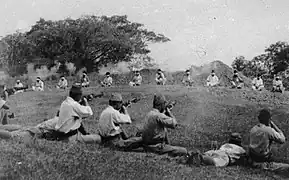Sikhism in Japan
Sikhism in Japan is a small, minority religion (Japanese: 日本のシーク教徒, romanized: Nihon no shīku kyōto, lit. 'Sikhs in Japan'). There are gurdwaras located in Tokyo, Ibaraki and Kobe.[1]
 The First Sikh Prime Minister of India, Dr. Manmohan Singh arrives in Tokyo to attend the Indo Japan Summit (Circa 2008) | |
| Total population | |
|---|---|
| 500 estimate | |
| Regions with significant populations | |
| Tokyo · Kobe · Kyoto | |
| Religions | |
| Sikhism | |
| Languages | |
| Punjabi · Japanese |
| Part of a series on |
| Sikhism |
|---|
 |
History
Pre-war period
Sikh royal, Jagatjit Singh of Kapurthala, visited Japan between 1903 and 1904, which left a deeply positive impression on him, leading him to write a memoir titled My Travel in China, Japan and Java in 1905.[2]
“From the standpoint of the traveller, Japan is perhaps one of the most interesting countries in the world; the country itself is full of delightful and varied scenery, while its people possess a charm of appearance and manner unlike anything of the kind to be met with elsewhere.”
— Maharaja Jagatjit Singh of Kapurthala, My Travel in China, Japan and Java (1905)[2]
Sikhs were present in Japan in the early 1920s and first began moving to the western region of Japan after the Great Kanto earthquake of 1923.[1] The Sikhs who lived in Yokohama at the time had their property destroyed in the earthquake and moved to Kobe to start a new beginning.[1] The population of Sikhs in the country was small at this time.[3]
World War II
Sikh soldiers encountered and fought against Imperial Japanese forces during the Second World War,[4] with some of the Sikh soldiers being taken as POWs and executed by the Japanese, often carried out as a "target practice" exercise.[5] Many Sikhs served in the Azad Hind army, working with the Japanese Empire to oust the British colonists from India.[6] Giani Pritam Singh and Amar Singh, two Sikhs, worked with Iwaichi Fujiwara to set-up the anti-colonial Indian Nationalist Army (Azad Hind).[6][7]
- Japanese soldiers shooting Sikh prisoners who are sitting blindfolded in a rough semi-circle about 20 yards away.




Post-war period

A gurdwara was established in Kobe in the year 1952.[3] Sikhs students have been in Japan since at-least the late 1960s, when some students from Punjab (India) traveled to the country to study abroad.[8] Sarbjit Singh Chadha, the first non-Japanese enka singer, was among these students.[8] Many Sikh asylum seekers (some of which have birthed children on Japanese soil) have been refused residency in the country and are threatened with deportation.[9] It has been observed that Sikhs in Japan who work low-skilled, blue-collar jobs at small or medium-sized enterprises tend to be mona Sikhs (shorn hair) whilst Sikhs working in the IT industry tend to be keshdharis (uncut hair with turban).[10] This is explained as smaller companies not understanding or being aware of the Sikh custom of letting hair grow naturally whilst IT companies give its Sikh employees more freedom in this regard.[10] Many Sikhs in the country cut their hair short in-order to integrate more easily in the Japanese way-of-life.[10] Some Sikhs have experienced racism at-first from their native Japanese neighbours, being mistaken as "terrorists" due to their unique appearance from the rest of the society, with the police keeping surveillance on them.[1] However, with time the locals came to accept the Sikhs and even began to take part in their religious activities, volunteering at the temple, and donating to Sikh causes, such as food for langar.[1] Many of the local Japanese who are associated with the religion are friends, colleagues, researchers, or spouses of ethnic Punjabi Sikhs.[1] Many ethnic Japanese wives of Sikhs have become believers and practitioners of the religion themselves.[1] In 1985, a Sikh bombed a Narita airport, killing two baggage handlers.[11] According to Azuma Masako, there were between 20,000 and 30,000 Sikhs in Tokyo during the late 1990s.[3] However, most of these Sikhs left the country and only around 500 of them remain, with 50 of those remainders being married to ethnic Japanese spouses.[3] The Sikh community in Kobe is more established and older whilst newer Sikh migrants mostly choose to settle in Tokyo.[3] Kobe Sikhs tend to hold on more to their Sikh identity and appearance, whilst Tokyoite Sikhs tend to shed their outward Sikh appearance to assimilate.[3] Many Tokyoite Sikhs are illegal aliens who have overextended on a tourist visa and remain in the country until they either marry a local person or get deported.[3] There are around 40–50 Sikh families living in Kobe.[3] Many Sikhs reject applying for naturalization in the country as they do not want to discard their Sikh names in the process.[3] Sikhs report experiencing little to no issues with donning a dastar and kirpan, including Sikh children attending Japanese schools who adhere to uniform rules.[3] Amongst Sikh families who have lived in the country for generations, knowledge of the Punjabi language and Gurmukhi script is fading from memory.[3]
Tomio Mizokami is a renowned Japanese academic who has studied the Punjabi-language and Sikh religion for decades, publishing many works and teaching courses on these subjects at universities.[12] He was born in Kobe, which has a large Punjabi and Sikh community, and became interested in the culture due to his early-life experiences interacting with the community.[13] In 2018, he was awarded the Padma Shri for his efforts in promoting Punjabi and Sikh culture.[14][15] He undertook the effort to translate Guru Nanak's Japji Sahib composition into the Japanese-language. He has also translated books about the Sikh religion into Japanese.[12]
Places of worship
A Sikh gurdwara was built in Tokyo in 1999, on the 300th anniversary of the establishment of the Khalsa Panth.[10] The Tokyo gurdwara is officially named the 'Tokyo Guru Nanak Darbar', serving the local Tokyoite Sikh congregation and those near the city, around 70 devotees in total as of 2016.[10][1] The Tokyo gurdwara is located in the basement of an office building.[10] It is only operational one day out of the month when religious services are held.[10] There is no committee or director of the Tokyo gurdwara.[10] Another gurdwara is located in Kobe and is in a residential area, it is officially known as the 'Guru Nanak Darbar Sahib'.[10][16] The Kobe gurdwara was established on former private dwellings of Indian migrants that were transformed fully into a gurdwara in 1966.[10][16]
List of notable Sikhs from Japan
- Sarbjit Singh Chadha – First non-Japanese enka singer
- Bob Singh Dhillon – Canadian businessman born in Japan.[17]
- Jaideep Singh – Kickboxer and mixed martial artist, Indian expatriate working for various Japanese MMA organizations.[18]
See also
References
- Wadhwa, Megha (24 August 2016). "Sikhs hope temple in Tokyo sets the stage for tolerance and understanding". The Japan Times. Archived from the original on 25 August 2016.
{{cite web}}: CS1 maint: unfit URL (link) - Kamalakaran, Ajay (29 June 2022). "The travelogue of an Indian maharaja who disliked China and loved Japan". Scroll.in. Retrieved 12 May 2023.
- Kahlon, Swarn Singh (2016). "Chapter 11 - Sikhs in Japan: Kobe's Old and Tokyo's New Immigrants". Sikhs in Asia Pacific: Travels among the Sikh Diaspora from Yangon to Kobe. Routledge. ISBN 9781351987400.
- Chowdhry, Mohindra S. (2018). Defence of Europe by Sikh Soldiers in the World Wars. 9781789010985. p. 331. ISBN 9781789010985.
- McCarthy, Preeti K. (17 November 2017). "Pictures emerge showing Japanese troops using Sikh POWs as practice targets". SBS Language. Retrieved 12 May 2023.
- Lebra, Joyce (2008). The Indian National Army and Japan. Institute of Southeast Asian Studies. p. 6. ISBN 9789812308061.
- Kulim, Gurcharan Singh (30 July 2015). "The REAL founder of the Indian National Army [INA] - Giani Pritam Singh Ji Dhillon". SikhNet. Retrieved 12 May 2023.
- "This Sikh singer from Delhi is a music sensation in Japan, check out his Japanese songs". The Indian Express. 20 April 2023. Retrieved 12 May 2023.
- Funakoshi, Minami; Miyazaki, Ami; Wilson, Thomas (22 November 2016). "Japan forces a harsh choice on children of migrant families". Reuters. Retrieved 12 May 2023.
- Azuma, Masako (2008). "Indians in Tokyo and Its Vicinity - The Case of the Sikh Community in Social Cohesion". Rising India and Indian Communities in East Asia. Institute of Southeast Asian Studies. pp. 263–66. ISBN 9789812307996.
- "Sikh convicted in Japan airport bombing - UPI Archives". UPI. 10 May 1991. Retrieved 12 May 2023.
- "Furthering Sikh & Punjabi Studies in Japan: Tomio Mizokami". Sikh Chic. 26 February 2013.
- "In spite of diversity, there is Indianess: Tomio Mizokami". WION. Retrieved 1 July 2019.
- Anand, Nisha (20 May 2023). "PM Modi praises renowned author Tomio Mizokami promoting Indian culture in Japan: Who is he?". Hindustan Times. Retrieved 30 May 2023.
- "In Japan, PM Modi meets linguist in Punjabi". The Tribune. Tribune News Service. 20 May 2023.
{{cite news}}: CS1 maint: others (link) - Wadhwa, Megha (2020). Indian Migrants in Tokyo: A Study of Socio-Cultural, Religious, and Working Worlds. Routledge Studies on Asia in the World. Routledge. ISBN 9781000207811.
Just as in various other countries in the world, one can find migrants from various areas of Punjab in Japan as well. The number is not as large as in countries such as Canada, the USA, UK and so on, but even within a small Sikh community, they have made efforts to set up a Gurdwara and Sikh association. The Guru Nanak Darbar Sahib in Kobe was for a very long time the only Gurdwara in Japan. The Nanak Darbar Sahib Gurudwara in Japan was first based in the house of an Indian migrant, and soon after that, in 1966, the Sikh committee was able to buy land for this Gurudwara, land that happened to be another house, this one also belonging to another Indian member of the community. This was renovated to create a proper Gurudwara, and since then it has been the permanent place for the Gurdwara in Kobe. In the beginning, an Indian migrant used to conduct the morning (prakash) and evening (sukhasin) prayers for a number of years, but after his death, the committee produced seven keys for the Gurdwara, and the morning and night prayers were assigned to the committee members. Occasionally the committee also invites a Ragi Jatha to come from India.
- "Bob Dhillon – Chapters of the First Sikh Billionaire". Darpan Magazine.
Dhillon was born in Japan in 1965. "My grandfather, Saproon Singh Dhillon left the village long ago for Hong Kong where he started a North China Shipping Company to carry goods to and from Japan where I was born. Then we moved to Hong Kong," says Dhillon
- "New Japanese promotion targeting Fedor Emelianenko vs. Jaideep Singh on New Year's Eve". MMA Fighting.
, however, sources with knowledge of the fight say the new Japanese promotion is targeting Indian-Japanese heavyweight kickboxer Jaideep Singh as his foe.
Further reading
- Masako, Azuma (2018). Sikh Diaspora in Japan (1st ed.). Routledge. ISBN 9780367029340.